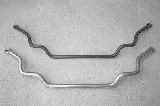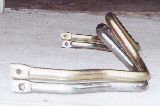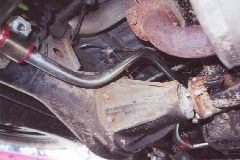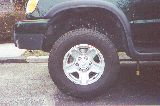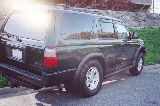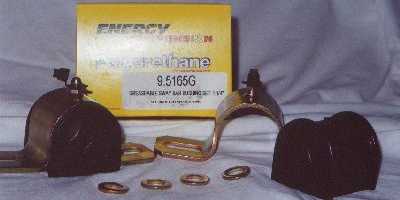 To Return to J.A.'s 4Runner HomePage...click here |
|---|
| Addco Anti-Sway Bars : One of the easiest and most cost effective ways to improve the handling of your truck is to install high performance front and rear anti-sway bars. High performance sway bars decrease body roll and keep the weight of the vehicle vertically over the tires, reducing drift, wheel lift and understeer. I have replaced the factory sway bars on my 4Runner with the versions made by Addco. Currently, it is the only company that manufactures sway bars for the Toyota 4Runner. You may notice sway bars marketed by Performance Products, and P-S-T, but Addco is the manufacturer of the sway bars for both those companies. The stiffness, or torque resistance, of an anti-sway bar is proportional to the diameter of the bar raised to the 4th power. Therefore a small increase in diameter of an identically shaped sway bar provides a major increase in anti-sway bar effectiveness. Please review the chart and pictures below to see the difference between the Toyota factory bars compared with Addco's version.
 Items included in Addco's Kit:
Items included in Addco's Kit:
Installation: Installation is straight forward. So I will just provide a few notes and tips. Before starting spray all nuts to be removed with a penetrating lubricant such as WD-40. Park the vehicle on flat ground. The use of a lift or supporting the vehicle by the frame and allowing the wheels to hang can cause bar misalignment and installation difficulties. The 4Runner is high enough to work on without using ramps, or other means that support the vehicle by the wheels. The job can be completed by one person working alone. I have decided to re-use the front Toyota end links rather than the ones provided by Addco. The Toyota endlinks have a ball joint built into the lower part and I wanted to retain that feature. When using the factory front endlinks you cannot use the red urethane bushings provided in the Addco kit. They are too tall and the nut cannot be put back on. You can use the Toyota rubber bushings but I decided to use the firmer Addco black urethane end link bushings up front. Their low profile works well when you factor in the larger ends of the new sway bar. When you remove the front sway bar brackets you will notice that it uses captive hardware, ie. it cannot be reused. Addco does not provide the nuts and bolts you need to install the front brackets. The specification of the nuts and bolts I used are listed in a section above. Originally I re-used the rear sway bar bracket bolts, but I do not recommend them. The factory bolts are M8x1.25x16mm with a 12mm head and they have a split lock washer. They were a little difficult to get initally threaded in to the frame due to the slight curvature of the Addco bracket and due to the flat washer I used to spread the load on the head of the bolt over the larger hole in the Addco bracket. After a few weeks one of the factory rear sway bar bracket bolts came loose and fell out. The bracket holding the bar bent and I had to order a new one. I now am using Grade 8.8 M8x1.25x20mm, with a 13mm head and a split lock washer and a flat washer. Also I boosted the 14ft/lbs of torque which Toyota recommends up some but I would recommend to be real careful to NOT strip the threads in the frame. I guess that would be worse than the bolt falling out?
When you are reinstalling the new sway bar brackets and polyurethane bushings, use plenty of lube to avoid squeaking and also make sure the cut in the bushings faces the front of the vehicle.
It was necessary for me to lift the vehicle to fish in the new rear sway bar.
I accomplished this by placing a wood board under the rear tow hitch and using
that as a jacking point.
Off Road Disadvantages: For those of you who are concerned with off-road performance as well, you should take into consideration that the improved cornering performance comes with a tradeoff. Because the sway bars connect both the left and right sides of the suspension together, it reduces their independence. Off road vehicles need as much ability for the axle to articulate as possible to keep the wheels on the ground while traveling over extremely uneven terrain such as rocks and gullies. By increasing the size of the sway bars, you loose some of this articulation ability. Differential lockers will help compensate for lack of articulation when a wheel is lifted in the air due to reduced flex, but on extreme trails you need all four wheels on the ground pulling to make it over steep obstacles. RockStomper sells quick disconnects so you can quicky and easily disconnect the sway bars from the endlinks giving you maximum articulation while off road. The following table shows measurements I took to see how much wheel travel is really lost with the larger sway bars and how much can be gained without any bars connected. I did not have access to a professional RTI Ramp (Ramp Travel Index), so I do realize my measurements will not be of exact precision. Please note these measurements are for my vehicle and yours will vary based on your individual vehicle set-up. All measurements were taken with stock springs, shocks, bumpstops, tires and air pressure.
Performance Review: I feel that the Addco sway bars were well worth the money for the improvement in on-road handling. They really help to control the near 4,000 pound SUV. It feels more stable at speed. The rig now corners nearly flat as body roll is significantly reduced. Originally I had decided to leave the rubber end link bushings on all around. But with the rear bar disconnected and the rubber bushings installed, you could literally pull on the end link shaft and really compress the bushings. I am glad I used the polyurethane bushings all around. I am sure they add to the stability during cornering. So far the bars do not appear to be too harsh during on-road driving. I do go off road driving a few times per year, but overall it is a very small percentage of my mileage. The trails I prefer to take my daily driver on are not too technical anyhow. So right now I am not too concerned with the loss of rear wheel travel as explained above. |
|||||||||||||||||||||||||||||||
| |
|||||||||||||||||||||||||||||||
| Greasable Sway Bar Bushings : The Addco red polyurethane sway bar bushings were very nice in both performance and appearance. You must lube those bushings before installing to avoid binding and squeaking. I used white lithium grease but I would recommend using some type of water resistant grease. The problem with the Addco bushings was that they needed re-lubing too often in order to eliminate the squeaking, which required totally removing all the sway bar brackets. So I decided to order Energy Suspension's greasable bushing set. I ordered from Sumitt Racing. They have Zerk fittings that are completely greasable using a standard grease gun, and come with a unique channel design that allows lube to migrate to all inner bushing surfaces. This design virtually eliminates binding, even under extreme loads from large diameter sway bars. If you order the Black bushings, like I did, they are the 'Poly-Graphite' type which further reduces squeaking. The 'G' at the end of the part number means the bushings are black, it does not indicate a greaseable bushing. Black is the only color with 'Graphite Impregnated' into the bushing. If graphite were added to the Red, Yellow or Blue, it would change the color to an ugly gray tinted bushing. The brackets for both the 1" and 1 1/4" bushings are identical. The only difference between the two sets is the diameter of the hole in the bushing itself. The brackets fit my 4Runner and I was able to insert the bolts with no difficulty. But in order for the washers provided in the set to lay 100% flat on the rear bracket some filing was needed. I used a round file to extend the holes (the side closest to the bushing) a few millimeters. I loaded a grease gun, now dedicated to lubing sway bar bushings only, with a Marine Grade Water Resistant grease cartridge. This green grease should help to keep the bushing lube from washing out during water crossings and heavy rain. And when re-greasing becomes necessary all I'll have to do is reach under and give the zerks few pumps with the grease gun. |
|||||||||||||||||||||||||||||||
